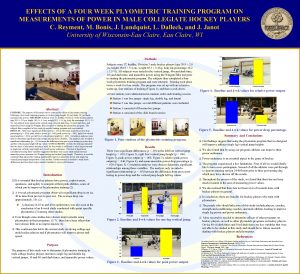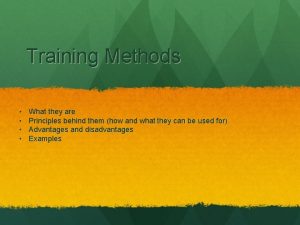EFFECTS OF A FOUR WEEK PLYOMETRIC TRAINING PROGRAM

- Slides: 1

EFFECTS OF A FOUR WEEK PLYOMETRIC TRAINING PROGRAM ON MEASUREMENTS OF POWER IN MALE COLLEGIATE HOCKEY PLAYERS C. Reyment, M. Bonis, J. Lundquist, L. Dalleck, and J. Janot University of Wisconsin-Eau Claire, WI Methods Subjects were 17, healthy, Division 3 male hockey players (age 20. 9 ± 2. 0 yrs, height 181. 9 ± 5. 4 cm, weight 85. 3 ± 5. 4 kg, body fat percentage 10. 2 ± 3. 5 %). All subjects were tested in the vertical jump, 40 -yard dash time, 10 -yard dash time, and anaerobic power using the Wingate Bike test prior to starting the plyometric program. The subjects then completed a four week plyometric training program and were retested. Training took place twice a week for four weeks. The program was set up with an extensive warm-up, four stations of training (Figure 1), and then a cool-down. q Four stations were administered in random order each training session Figure 4. Baseline and 4 -wk values for relative power output. Station 1 was box jumps: single leg, double leg, and lateral Station 2 was line jumps: several different patterns were included Abstract PURPOSE: The purpose of this study was to examine the effects of plyometric training following a four week training program on vertical jump height, 40 yard dash, 10 yard dash, and anaerobic power. METHODS: Subjects were 17, healthy, Division 3 male hockey players (age 20. 9 ± 2. 0 yrs, height 181. 9 ± 5. 4 cm, weight 85. 3 ± 5. 4 kg, body fat percentage 10. 2 ± 3. 5 %). All subjects were tested in the vertical jump, 40 -yard dash time, 10 -yard dash time, and anaerobic power using the Wingate Bike test prior to starting the plyometric program. The subjects then completed a four week plyometric training program and were retested. RESULTS: There were significant differences (p <. 05) in the mean anaerobic power drop percentage (p =. 020), peak relative power (p =. 046), peak power (p =. 005), right foot vertical jump height (p =. 046), and left foot vertical jump height (p =. 001). Correlation analyses were done to determine significant relationships among these variables. The analysis only revealed a significant relationship (p <. 05) between the difference from pre to post testing in power drop and the vertical jump height left leg values. CONCLUSIONS: Overall, the findings indicated that two days of plyometric training a week for four weeks is sufficient to elicit improvements in single leg vertical jump height and overall power endurance. The lack of significant correlations among these variables suggested that there was a poor relationship between anaerobic power measures via Wingate testing and vertical jump height. Therefore, it could be concluded that plyometric training significantly improves anaerobic power and single leg vertical jump height independent of one another. Further research is needed to study these differences and how these improvements translate to on-ice performance. Introduction Station 3 consisted of Russian box jumps Station 4 consisted of the slide board exercise Figure 5. Baseline and 4 -wk values for power drop percentage. Summary And Conclusions Figure 1. Four stations of the plyometric training program. Results There were significant differences (p <. 05) in the left foot vertical jump height (p =. 001; Figure 2), right foot vertical jump height (p =. 046; Figure 2), peak power output (p =. 005; Figure 3), relative peak power output (p =. 046; Figure 4), and mean anaerobic power drop percentage (p =. 020; Figure 5). Correlation analyses were done to determine significant relationships among these variables. The analysis only revealed a significant relationship (p <. 05) between the difference from pre to post testing in power drop and the vertical jump height left leg values. power endurance. q Power endurance is an essential aspect to the game of hockey. q The program experienced a few limitations. First of all we would ideally like to have more participants. Second of all the athletes were put through a vigorous training session 24 -48 hours prior to their post-testing day, which may have thrown off the results. q We also noticed that there has not been a lot of research done with hockey players in general. 40 m time from pre test to post test. The average drop was approximately. 15 s (2). q In conclusion, there are benefits for hockey players who train with plyometrics. A decrease in 10 m and 40 m sprint times was also seen at the conclusion of an 8 -week study conducted with sprint specific plyometrics (3) among other studies. q The people who should take note of this study include players, coaches, strength and conditioning coaches, and male athletes looking to improve single leg power and power endurance. Figure 2. Baseline and 4 -wk values for one-leg vertical jump. Watts q This confusion has led to the current study involving college age male hockey players and if plyometrics will improve power and speed. q We also found that by using our program, athletes can improve their much research in the area of measuring power values. q A 4 -week plyometric program observed a significant drop in on ice plyometrics in their programs, (2 -7) , there have been others that have shown little or no improvements (1). will improve athletes single leg vertical jump heights. q Throughout the process of the study, we found that there has not been q It is essential that hockey players have power, explosiveness, quickness, and agility to compete at their peak abilities, some of which can be improved by plyometric training (2). q Even though some studies have shown improvements using q Our findings suggest that using the plyometric program that we designed Purpose The purpose of this study was to determine if plyometric training in male college hockey players increases single leg and double leg vertical jumps, 10 and 40 yard dash times, and anaerobic power values. Figure 3. Baseline and 4 -wk values for peak power output. q More research is needed to determine effects of other programs on hockey players, as well as other plyometric programs on hockey players. On-ice 40 yd dash times and 10 yd dash times are key variables that were not able to be studied in this study and should be in future research dealing with hockey players and plyometrics. References 1)Luebbers, Paul E. et al. Effects of Plyometric Training and Recovery on Vertical Jump Performance and Anaerobic Power. Journal of Strength and Conditioning Research. 2003; 17: 704 -9. 2)Brophey, Patrick. Kelly L. Lockwood. The Effect of a Plyometrics Program Intervention on Skating Speed in Junior Hockey Players. The Sport Journal. 2004; 7: [np]. 3)Rimmer, E. G. Sleiver. Effects of a Plyometrics Intervention Program on Sprint Performance. Journal of Strength and Conditioning. 2000; 14: 295 -301. 4)Polhemius et al. The effects of plyometric training with andle and vest weights on conventional training programs for men. Track and Field Quarterly Review. 1980; 80: 59 -61. 5)Green, Mathew R. et al. Relationship between Physiological Profiles and On-Ice Performance of a National Collegiate Athletic Association Division I Hockey Team. Journal of Strength and Conditioning Research. 2006; 20: 43 -6. 6)Maffiuletti, et al. Effect of combined electrostimulation and plyometric training on vertical jump height. Medicine and Science in Sports and Exercise. 2002; 34: 1638 -44. 7)Wilson, GJ. Weight and plyometric training: effects on eccentric and concentric force production. Canadian Journal of Applied Physiology. 1996; 21: 301 -15.

